This article was medically reviewed by Troy A. Miles, MD. Dr. Miles is an Orthopedic Surgeon specializing in Adult Joint Reconstruction in California. He received his MD from the Albert Einstein College of Medicine in 2010, followed by a residency at the Oregon Health & Science University and fellowship at the University of California, Davis. He is a Diplomat of the American Board of Orthopaedic Surgery and is a member of the American Association of Hip and Knee Surgeons, American Orthopaedic Association, American Association of Orthopaedic Surgery, and the North Pacific Orthopaedic Society.
There are 7 references cited in this article, which can be found at the bottom of the page.
This article has been viewed 96,465 times.
Ankle pain is caused by many different conditions including sprains, arthritis, gout, or nerve damage.[1] The most common cause of ankle pain is a sprain. In many cases, ankle pain will heal on its own with home treatment. By following the RICE principle and trying medication and gentle movement, you can relieve pain in your ankle.
Steps
Using RICE
-
1Follow the RICE principle. Ankle pain often goes away by using the RICE treatment. RICE—Rest, Ice, Compression, and Elevation—can relieve your pain and may prevent other issues.
- Use RICE for immediate self-care of ankle pain.
-
2Rest your ankle and leg. Let your leg rest completely or do lower-impact activities. Immobility and light activities such as swimming may help relieve your ankle pain and promote healing.[2]
- Switch to lower-impact sports if you do high-impact activities like running. Try an exercise bike or swimming to stay active while resting your leg. You can modify both activities to avoid using your hurt ankle.
- Consider giving your ankle a few days of complete rest.
- Use a cane or crutches if necessary.
- Move your ankle gently after a few days of full rest to help prevent stiffness.
Advertisement -
3Ice your ankle. Apply an ice pack to your ankle. This minimizes swelling and can help relieve pain.[3]
- Put ice on your ankle for 20 minutes at a time three to five times a day.
- Use a commercial ice pack or make your own with a bag of frozen vegetables or fruit. You can also freeze a plastic foam cup of water and then gently massage your ankle with it.
- Placing your ankle in slush bath can also help. Make a slush bath by mixing ice and water in a bathtub. Soak your ankle for up to 20 minutes.
- Wait 90 minutes between icing sessions.
- Take the ice off of your leg if it gets too cold. Put a towel between the ice pack and your skin to help prevent frostbite.
-
4Compress your ankle. Wrap your ankle with an elastic bandage to compress your ankle.[4] This can reduce swelling, relieve pain, and preserve mobility in your ankle joint.
- Wrap your ankle beginning with the part farthest from your heart.
- Make sure you don’t wrap too tightly. If your toes turn blue or go numb, pain increases, or you see swelling below the wrapped area, loosen the wrap.
- Use compression you don’t see any more swelling.
-
5Elevate your ankle. Raise your ankle above heart level.[5] Elevation can reduce swelling and may also relieve your pain.
- Prop up your ankle with a stack of pillows or another structure that will support it.
- Keep your ankle up as much as you can. It’s important to keep it elevated at night if you can.
Taking Medication and Getting Treatment
-
1Take an over-the-counter pain reliever. If you are in a lot of pain or have swelling, consider over-the-counter pain medications, which can reduce pain and swelling.[6]
- Use pain relievers such as aspirin (do not give aspirin to children), ibuprofen (Advil, Motrin IB), naproxen sodium (Aleve) or acetaminophen (Tylenol).
- Reduce swelling with NSAIDs (nonsteroidal anti-inflammatory drugs) like ibuprofen and naproxen sodium.
-
2Try an analgesic. Analgesics are common medications used to relieve ankle pain from arthritis, sprains, or other injuries.[7] Either take or apply an analgesic to your ankle to relieve pain.[8]
- Be aware that analgesics only address pain and won’t reduce swelling.[9]
- Rub an analgesic cream on your ankle. You can get over-the-counter topical analgesics under names such as Aspercreme, Ben-Gay, Capzasin-P, Eucalyptamint, and Icy Hot.
- Ask your doctor to prescribe a stronger topical analgesic such as Voltaren Gel.
-
3Control arthritic pain and inflammation with corticosteroids. If your ankle pain and/or inflammation is due to arthritis in your ankle, ask your doctor to prescribe either an oral corticosteroid or give you an injection.[10] Corticosteroids can relieve pain and inflammation very quickly.[11]
- Corticosteroids should not be used for acute injuries like sprains. They can impair the healing process and can have many side effects, including high blood pressure, glaucoma, cataracts, headache, weight gain, ulcers, and more.[12]
-
4Move your ankle. After a few days, start gently moving your ankle.[13] This can help relieve pain, prevent stiffness, and get you back to regular activities.
- Rotate your ankle in circles in both directions.
- Flex your ankle up and down with your hand.
- Ask your doctor if there are any movements or light exercises that can relieve your pain and promote healing.
-
5Get physical therapy. Consider seeing a physical therapist to help stretch and strengthen your ankle. It may relieve your pain and inflammation.
- Schedule an appointment with a physical therapist after you’ve tried RICE.
- Ask the therapist questions you have about exercises you can do at home.
- Consider that studies have shown the benefits of eccentric stretching, which lengthens muscles, on pain-causing conditions such as tendinitis.[14]
-
6See your doctor. If your pain doesn’t go away within a few weeks, schedule an appointment with your doctor. She can help rule out more serious conditions such as a fracture, gout, or arthritis.[15]
- See your doctor or go to an emergency room immediately if you can’t put weight on your ankle or it appears broken, have severe pain even when you’re resting, or if your ankle makes a popping sound when you move it.
- Visit your regular doctor or an orthopedist, which is a doctor who specializes in structural conditions like sprains and arthritis.
- Tell your doctor about your symptoms and what type of treatment you’ve been using.
- Ask her any questions you may have about your ankle pain.
-
7Have medical treatments. Depending on the outcome of your doctor’s appointment, you may need medical treatment for your ankle pain. These can relieve your pain and manage underlying conditions.[16] Some possible medical treatments for underlying causes of ankle pain include:
- Disease-modifying anti-rheumatic drugs (DMARDs) for inflammatory arthritis (such as rheumatoid arthritis, psoriatic arthritis, ankylosing spondylitis)
- Biologic response modifiers like interferon for inflammatory arthritis
- Uric acid-reducing drugs for gout such as allopurinol
- Drugs that slow bone loss or build new bone for osteoporosis such as denosumab.[17]
Warnings
- These treatments are not intended as a substitute for medical diagnosis or treatment. Always seek the advice of your physician or other qualified health care provider if you are unsure of something.⧼thumbs_response⧽
References
- ↑ https://my.clevelandclinic.org/health/symptoms/15295-ankle-pain
- ↑ https://my.clevelandclinic.org/health/symptoms/15295-ankle-pain
- ↑ https://my.clevelandclinic.org/health/symptoms/15295-ankle-pain
- ↑ https://www.versusarthritis.org/about-arthritis/conditions/foot-and-ankle-pain/
- ↑ https://www.nhs.uk/conditions/foot-pain/ankle-pain/
- ↑ https://my.clevelandclinic.org/health/symptoms/15295-ankle-pain
- ↑ http://www.arthritis.org/about-arthritis/where-it-hurts/ankle-pain/treatment/ankle-arthritis-medication.php
- ↑ http://www.arthritis.org/about-arthritis/where-it-hurts/ankle-pain/treatment/ankle-arthritis-medication.php
- ↑ https://rejuvenateyourhealth.org/6-of-the-best-ankle-pain-remedies-and-treatment-options/
- ↑ http://www.arthritis.org/about-arthritis/where-it-hurts/ankle-pain/treatment/ankle-arthritis-medication.php
- ↑ http://www.arthritis.org/about-arthritis/where-it-hurts/ankle-pain/treatment/ankle-arthritis-medication.php
- ↑ http://www.medicinenet.com/corticosteroids-oral/page4.htm#what_are_the_side_effects_of_systemic_corticosteroids
- ↑ https://www.nhs.uk/conditions/foot-pain/ankle-pain/
- ↑ https://www.dukehealth.org/treatments/orthopaedics/ankle-pain-and-ankle-injury
- ↑ https://www.nhs.uk/conditions/foot-pain/ankle-pain/
- ↑ http://www.arthritis.org/about-arthritis/where-it-hurts/ankle-pain/treatment/ankle-arthritis-medication.php
- ↑ http://www.arthritis.org/about-arthritis/where-it-hurts/ankle-pain/treatment/ankle-arthritis-medication.php
About This Article
If you’re suffering from ankle pain, it’s important to rest as much as possible so you don’t put any more pressure on it. While you’re resting, keep your ankle elevated above your heart level, even at night. You can prop it up on a stack of pillows to support it and help reduce swelling. If you need to walk around, use a cane or crutches. Apply an ice pack or bag of frozen vegetables wrapped in a towel to your ankle for 20 minutes a few times a day. This will help reduce the swelling and pain. Wrapping your ankle with an elastic bandage will also help with the swelling. If you’re still in pain, take an over-the-counter pain reliever like aspirin, ibuprofen, or acetaminophen. If your pain doesn’t improve within a few weeks, visit your doctor for treatment. For more tips from our Medical co-author, including how to get physical therapy for your injured ankle, read on.
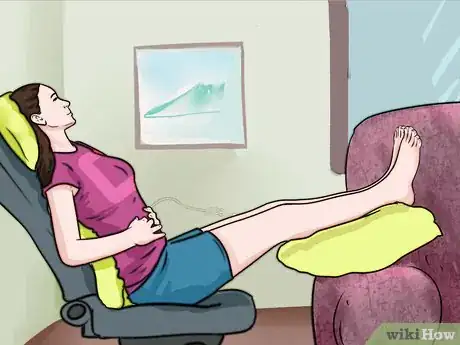




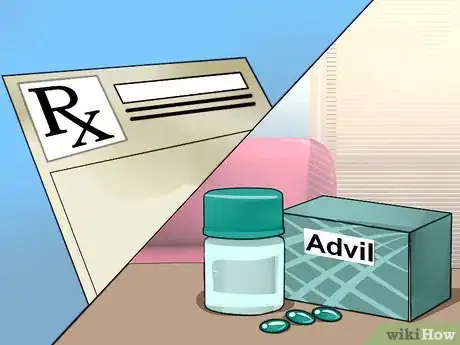
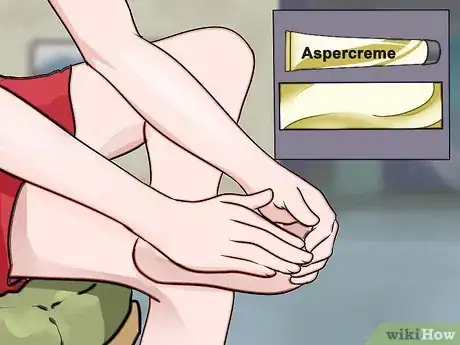

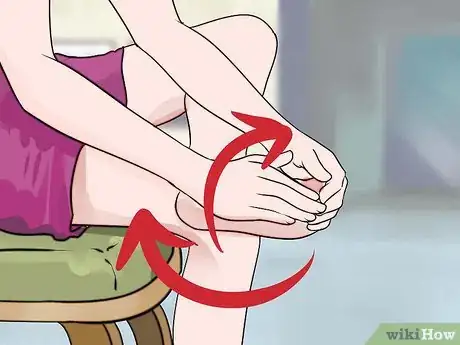
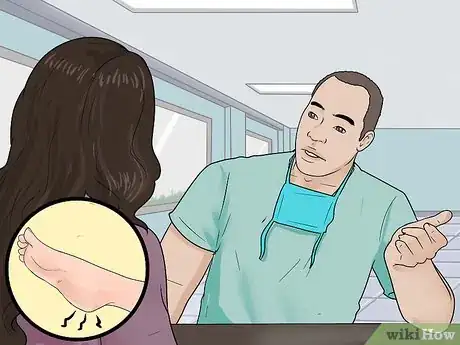

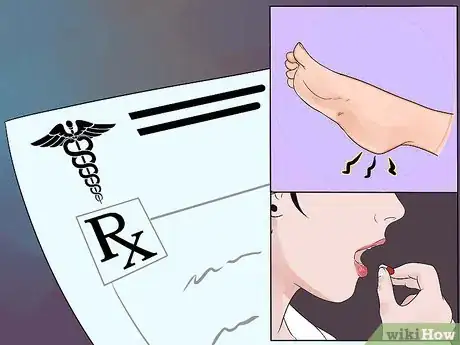
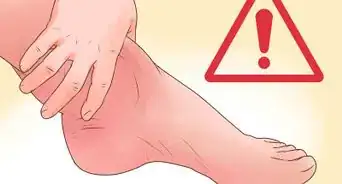

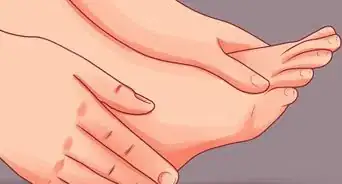






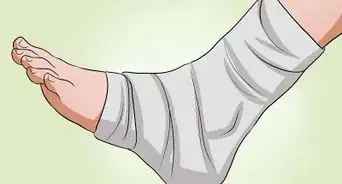








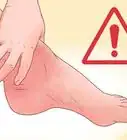

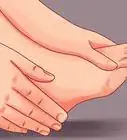




































Medical Disclaimer
The content of this article is not intended to be a substitute for professional medical advice, examination, diagnosis, or treatment. You should always contact your doctor or other qualified healthcare professional before starting, changing, or stopping any kind of health treatment.
Read More...